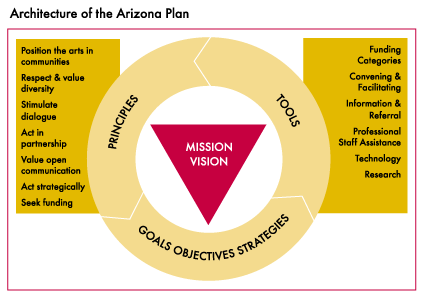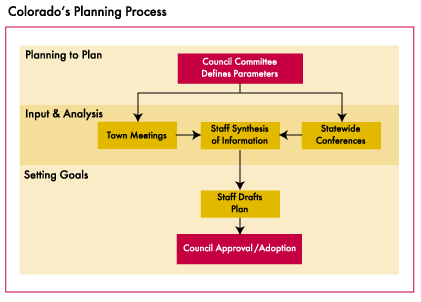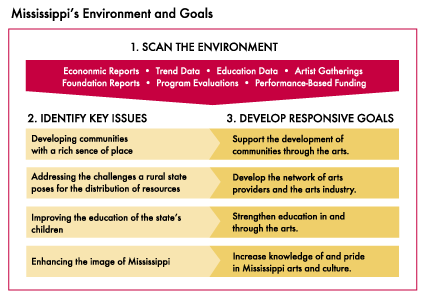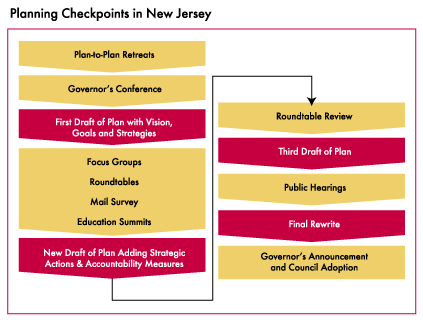“Mainers are known for their ability to find opportunity in adversity, and we have used the fiscal downturn to reevaluate the entire work of the Maine Arts Commission.” So goes a sentence in a report describing the impetus for the long-range strategic planning process that began in 1995 and resulted in The Maine Arts Commission: 1996 and Beyond.Facing a significant loss of its regular funding base, the Maine Arts Commission (MAC) decided to seize the moment as a positive opportunity to completely reimagine its structure, its programs and its relationship with constituents. The eight-month process had the following chronology:
- in-depth analysis by the commission
- hiring of consultants (and staff contact with them throughout the process)
- distribution of a written survey
- commission retreat
- statewide public meetings
- meetings with potential programming partners
- draft of the new agency plan, with solicitation of comments
- six open commission meetings
- commission adoption of the plan
Executive Director Alden Wilson estimates that he committed 50 percent of his time to working on the plan, with Assistant Director Peter Simmons devoting 30 percent and agency program directors spending 10 to 15 percent of their time on planning efforts.Aware of how restructuring might affect the field and public perception of the arts commission, the agency provided many opportunities for interchange and public input. This was done through extensive inclusion in planning and implementing every projected program, and through the creation of program-specific task forces and implementation committees. The implementation committees consist of MAC board members (committee chairs are all commission members and all sit on the commission’s Executive Committee) and field-based constituents, including practicing artists and representatives of affected organizations. Members serve for several years, working out the details of a particular program area in the plan, consulting on guidelines and the review process, evaluating program outcomes and reporting to the Executive Committee and the full commission.

There was also some data review through written surveys and through examination of prior grant making, which showed the agency that:
- its programs were not aimed at a diverse constituency,
- its programs and episodic grants were not providing or fostering stability, and
- there were whole areas of the state that were not being served.
Armed with this data, the agency created a new vision born partly from the necessities of adversity, partly from an already long-held dissatisfaction with the competitive nature of grant making in some of the programs, and partly from a strong desire to bridge the gap between the grantees and their communities. There was an overarching need to bring into strong alignment the agency’s staff, its commission and the citizens of Maine.With this in mind, the plan made partnerships a priority. One of its seven guiding principles is: “Work collaboratively and promote collaboration in order to increase the effect of the Commission’s resources, and to foster relationships and commitments that build infrastructure beyond the Commission’s involvement.” This principle is now melded with all the agency’s activities, including program guidelines, which ask that applicants refer to the guiding principles in their narratives and show evidence of partnerships.
The agency made sure that artist involvement remained high through regularly canvassing individual artists (as Simmons says, “Maine is a state of artists, more than organizations”), and by making artists central to the plan. In fact, the very first guiding principle of the plan is “…to value artistic quality and cultural diversity.” Artist fellowships became one area where there were no cutbacks in the plan.
In order to ensure flexibility—an absolute necessity in a plan that called for major changes with uncertain outcomes—another guiding principle was, “Be flexible and adaptive in the way the agency functions in order to take advantage of opportunities, to respond to needs more effectively, and to incorporate what it learns from its experience.” As Wilson explains, “We were changing everything, so it couldn’t be done all at once. We had to show in the plan that we’d change programs bit by bit. Each area had several potential outcomes and we need to retain flexibility to explore options over time.”
The agency uses implementation committees to oversee evaluation of progress on all the goals and programs. The planning process helped the agency cultivate a closer working relationship with the legislature’s Education and Cultural Affairs Committee and its Appropriations Committee, which in turn has helped with understanding and fulfilling the state’s performance-based budgeting process. Keeping the plan alive is not an issue because of the interlocking relationships between programs with longer lives and therefore longer reporting relationships, plus the strong buy-in from council and staff to maintaining the new vision. The plan is at the center of staff retreats, staff meetings, and committee and council meetings. The structural integration of the plan is the crucial mechanism that keeps it dynamic. “The plan has to be alive because we are still working on it,” explains Wilson.
The plan was disseminated in a number of ways—through direct mail to 3,500 people and organizations, and in an edited version for the agency’s website. But the most effective form has been the inclusion of key components of the plan in the agency’s guidelines, where it is most often seen and read.
One area of difficulty during planning was the potential resistance of some arts organizations to engage in change, especially larger established organizations that had the ear of political figures. But this was a risk worth taking, as the process vastly improved the working relationship between the commission and MAC staff, and ultimately succeeded in making the legislature much more invested in the agency (evidenced by the funding of two major initiatives—arts in education and the New Century Program—representing a 145 percent increase in total appropriations).
Both Wilson and Simmons proffer some advice to others about planning:
- Take a very long view, both backward and forward.
- Build opportunistic qualities into your plan and planning process.
- Consider your own state very carefully—where you come from is important.




